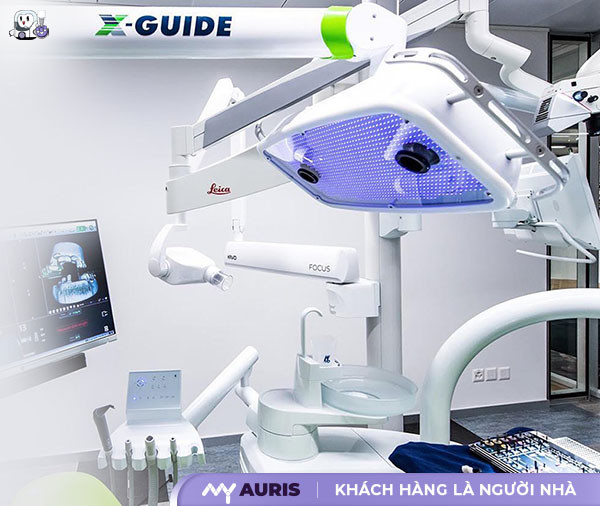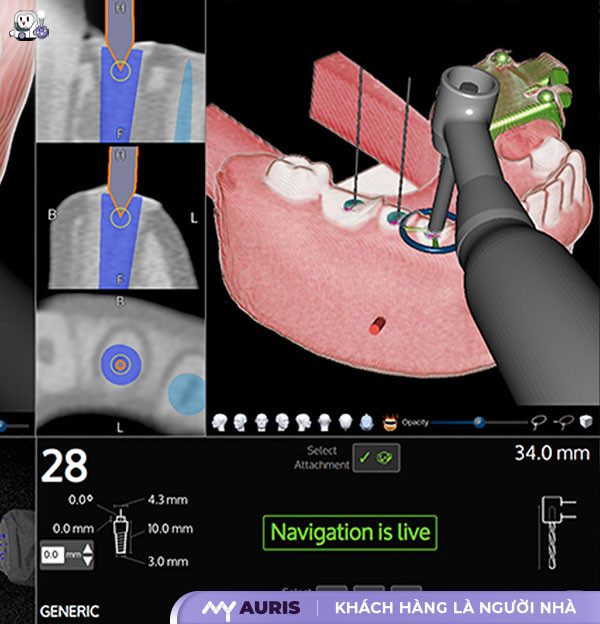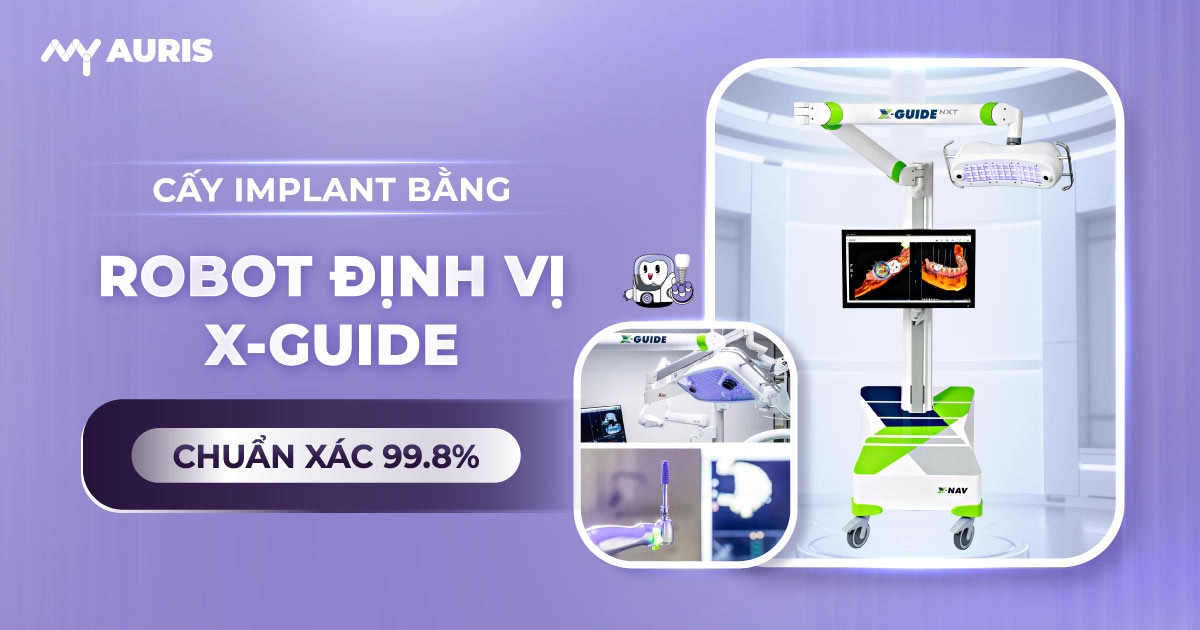With the support of the modern X-Guide navigation robot, dentists can flexibly adjust the type and size of the implant post during surgery, adapting to each patient’s complex anatomical characteristics. As a result, the implant placement procedure is more precise, safer, and gentler, minimizing soft tissue damage and reducing the risk of post-surgical infection. This system not only shortens recovery time but also delivers natural, stable, and long-lasting aesthetic results.
What is Dental Implant Placement using X-Guide Robotic Navigation Technology?
The implant placement technology using the X-Guide robot (Implant Navigation) is a breakthrough in the dental implant industry, effectively applying surgical robots and modern imaging diagnostics. This system integrates two observation cameras directly connected to 3D Cone Beam CT software, allowing the dentist to observe the drill’s coordinates and evaluate its correlation with anatomical structures on a real-time electronic screen.
With the X-Guide robotic dental implant navigation system, dentists can change the implant type and flexibly adjust the size of the implant post to suit complex clinical anatomical conditions, right during surgery. This is a crucial factor in ensuring near-absolute accuracy of implant placement.
The X-Guide Navigation dental implant placement technology was researched and first published by Dr. Nardy Casap in 2004. A notable feature of this technology is the integration of visual imaging, an audible alarm system, and warning signals when the drill deviates from the initial positioning. This ensures a safe implant post placement process while achieving near-absolute accuracy in placement.
After nearly 20 years in operation, X-Guide implant placement technology has demonstrated superior effectiveness and is recognized as the most advanced technology supporting dental implants today. This technology has been widely applied in European countries, the US, Japan, etc., and continues to spread globally.

Outstanding Advantages of X-Guide Robotic Navigation Implant Placement Technology
Modern dental implant technology has entered a new era with the support of the X-Guide navigation robot – a breakthrough in dental surgery. This technology offers many superior benefits, making the treatment process safer, faster, and many times more effective than traditional methods.
Near-Absolute Placement Accuracy of 0.1mm
With accuracy up to 0.1mm, the X-Guide dental robot allows for nearly absolute tooth placement, with a deviation of only 0.1mm. The dentist, monitoring on screen, will clearly see the real-time image of the drill’s trajectory, ensuring the implant post is placed precisely as required, from the exact angle to the precise depth, just as initially planned.
11 Times Higher Safety and Speed Compared to Old Methods
The X-Guide robotic navigation system integrates a comprehensive warning system with sound, signals, and images. If the drill deviates from the correct position, the system issues a warning, allowing the dentist to make timely adjustments. This results in 11 times higher safety compared to traditional implant placement. Additionally, the implant placement time is reduced by 1/11, significantly saving treatment time.
Minimizing Post-Implant Pain and Swelling
Unlike traditional methods, this technology only requires implant placement at a single location, which helps limit the expansion of the gum wound. Thanks to the narrowed surgical area, patients will experience pain-free, swelling-free tooth implantation, and significantly reduced post-implant pain and swelling.
Success Rate Up to 99.8% – Rapid Recovery
With a success rate of up to 99.8%, X-Guide robotic navigation dental implant technology helps minimize soft tissue damage, thereby enabling rapid recovery after implant post insertion. This not only saves treatment time but also provides absolute peace of mind for patients.
Minimizing the Need for Bone Grafting
Specifically, when using X-Guide technology, jawbone is maximized, helping to minimize the need for bone grafting, which is particularly effective in cases of maxillary bone resorption near the sinus cavity. As a result, the implant placement process becomes much smoother and less invasive.

Disadvantages of X-Guide Robotic Navigation
Although the X-Guide navigation robot is considered a tooth implant technology with superior advantages over traditional methods, there are still some limitations that patients need to understand before deciding on treatment.
Requires Highly Qualified and Skilled Dentists
This is a common disadvantage of the X-Guide navigation robot. Using the X-Guide robot for implant placement cannot be performed by inexperienced dentists. Dentists performing implant placement must be well-trained, possess extensive professional knowledge, and have studied medical programs both domestically and internationally. To ensure the best treatment outcomes, individuals should choose a dental clinic with highly experienced dentists who are reputable in the dental industry and highly regarded for their skills.
Requires Modern, Synchronized Equipment
One of the key factors contributing to the effectiveness of X-Guide robotic navigation technology is medical equipment. The dental clinic must possess a modern equipment system capable of meeting the specific software requirements of the X-Guide robot. All machinery needs to be genuinely imported to ensure the accuracy of information throughout the implant placement process. When visiting a dental clinic for examination, individuals should pay special attention to the equipment and instruments in the clinic to evaluate and decide on a dental clinic for implant placement that suits their needs and expectations.
High Cost Deters Many People
Compared to traditional tooth implant methods, the cost of X-Guide robotic implant placement is considerably higher. This difference stems from the high requirements for the dentist’s expertise and the advanced equipment. This is an issue that makes many people hesitant when deciding to use modern dental technology. However, considering the long-term effectiveness and superior precision, this initial investment is entirely worthwhile.

Modern X-Guide Navigation Robotic Implant Placement Process
Compared to traditional dental implant placement technology, which required a week to fabricate an implant guide and time to determine the implant post position, dental technology has made remarkable breakthroughs today. X-Guide Robotic Navigation Implant Placement technology allows for single-appointment implant placement, eliminates the need for guides, significantly shortens treatment time, and ensures high accuracy.
At the Dental Clinic, the dental implant placement process using navigation technology is carried out in 8 steps according to international standards, guaranteed by a team of experienced dental professionals, committed to ensuring the best treatment outcomes for each patient.
Step 1: General Examination
The dentist will conduct a general oral health examination to assess the current condition. In cases of oral diseases, the patient will be fully treated before implant placement to ensure a smooth recovery process.
Step 2: CT Scan using a 3D Cone Beam Machine
Using a modern 3D Cone Beam CT scanner, the dentist captures clear images of the jawbone, teeth, and nerves. This serves as the basis for precise analysis of jaw structure, bone loss, or sinus conditions, if any.
Step 3: Treatment Planning using Navigation Technology
Next, treatment planning using navigation technology is performed on the software. 3D images of the treatment area and coordinates will be displayed on the screen, helping the dentist determine the appropriate implant placement position, implant placement direction, and accurately predict the appearance of the restored dentition.
Step 4: Instrument Sterilization – Oral Cavity Cleaning
All instruments, machinery, and the treatment room are rigorously sterilized. Concurrently, thorough oral hygiene is performed to prepare for the tooth implant step.
Step 5: Rapid Implant Post Placement
The patient receives local anesthesia to ensure painlessness during bone preparation and implant post placement. Thanks to X-Guide navigation technology, implant post placement takes only 25-30 minutes, minimizing invasiveness.
Step 6: Follow-up – Suture Removal after 7-10 Days
After 7-10 days, the patient returns for a follow-up, where the dentist assesses the healing progress and removes sutures. The wound heals quickly, ensuring safety requirements thanks to modern technology.
Step 7: Impression Taking – Temporary Crown Placement
After suture removal, the dentist takes an impression to fabricate the final ceramic crown and places a temporary crown to ensure the patient’s chewing ability, prevent food from getting trapped in the wound, and help them get used to the temporary prosthetic tooth.
Step 8: Final Ceramic Crown Placement – Completion of Process
2-4 months later, the patient returns for a follow-up to confirm jawbone recovery and integration with the implant post. Once the implant post meets requirements, the dentist proceeds with placing the final ceramic crown, completing the implant placement process. Finally, the patient receives instructions on daily oral hygiene to maintain long-lasting results.
Modern X-Guide robotic navigation implant placement technology has been successfully implemented by My Auris Dental Clinic, offering high precision and shorter treatment times. This advanced solution provides patients with greater peace of mind when restoring lost teeth. For detailed consultation on the process, costs, and long-term effectiveness from My Auris Dental Clinic’s highly qualified medical team, please contact hotline 0906038017.





